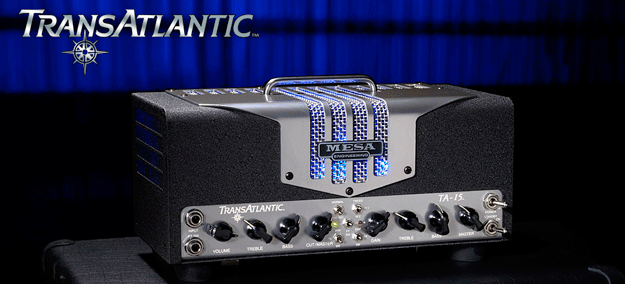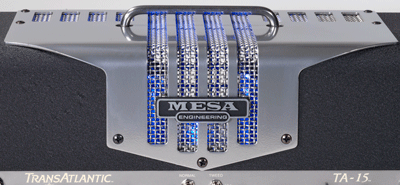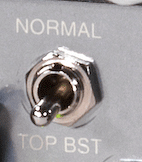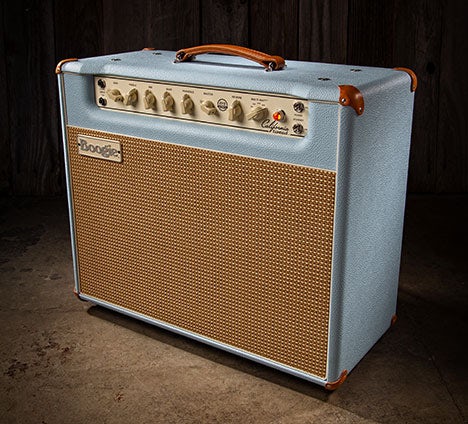Amplitudes: The Mesa Boogie Blog
Guitar Products
TransAtlantic® Voyage: Launch of the Lunchbox

By Randall Smith
Electronics first sparked my curiosity back in the mid-50s, just ten years after World War II. I was about ten myself and this was the prelude to my building hi-fi and ham radio gear. A couple of us kids would hop a bus across the bridge into San Francisco and down to lower Market Street, before it was porn palaces and derelicts in doorways. There were a couple of surplus stores down there selling all sorts of left-over war material, some new and never delivered, some used and much abused—it actually HAD been to war!
Standard Surplus and Marty’s Mart were the two biggies. On the ground floor was the good stuff (if you could figure out a use for it), but down below – down where you weren’t supposed to go – were unsorted piles of unimaginable electronics: giant transmitters with tubes the size of watermelons, huge radar racks, bizarre-looking antennas. The stuff looked powerful and dangerous and I was hooked.
One time, after sneaking down there, I wanted to see how far back Marty’s basement went. There was only one light bulb at the bottom of stairs, and I had to let my eyes adjust to the darkness. I crept back further and further underground until I came to the end where the concrete floor faded out and a sloping grade of dirt rose in front of me, like they just got tired of digging. But even this muddy underground cavern was littered with copper tubing, broken glass and piles of dirty electronics.
Then, a loud noise from the front. The big steel hatch that covered the sidewalk was opening and light flooded in. I froze. Voices. Somebody coming. I held my breath and hid way back in the shadows, up against the dirt.
Then I realized what they were doing: That hatch covered a freight elevator that went up to the sidewalk. While I hid back there, several new loads of gear were brought down from above. Then, while the elevator was all the way down, the guy on the street hollered a warning as a five-foot tall rack of electronics fell in from above and crashed to the floor. The guy in the basement cursed out the guy above, then, as he tipped up the rack, they both laughed when they heard all the broken glass inside.
They closed the elevator hatch and when I was sure they were gone, I crept forward and carefully checked out that rack of gear.
Black Crinkle Paint. That was the finish on that rack and on most of the hard-core radio gear back then. I grew up with it and that memory inspired the finish on the TransAtlantic. It’s a tough industrial look, dated, but classic and a great contrast to the “old chrome” finish of the vent grille.

That’s another piece of the TransAtlantic inspired by my past, by the grille on a ’39 Ford – one of the most hot-rodded cars of all time. My cousin had one, my best friend in high school had one, and I’ve still got busted knuckles from wrenching on the “flatty” inside. (No, that’s not a TV; that’s the flat-head V8 that made those cars so potent and ruled the ‘rod world until the small-block Chevy came of age.)
Chicken-head knobs were definitely part of this era and both Vox and Fender used ‘em. The blue glow from inside is provided by a row of modern LEDs — but check ‘em out from the back: they kind of look like foot lights on a stage. That pop-up handle — remember where you saw it first. OK, enough about the looks, let’s talk about the TransAtlantic electronics and how both sides of “the Pond”, old and new, are represented in this little box.
Channel 1

Channel 1 is our interpretation of the legendary Vox AC circuit, from the era when Vox actually was Vox: the British company, and not an offshore factory using the historic name. We’re neither the first nor last to pay homage to this British classic, and, like most great amplifiers, you can find its predecessor in the Fender history – the circuit looks quite a lot like the 5E3 Deluxe. What Vox did was change the power tubes from 6V6 to EL84s and when they introduced tone controls in the Top Boost model, they used Treble components whose value enhanced that great chiming top-end brilliance. I’ve come to think these amps were under-appreciated at the time, certainly in the Bay Area music scene of the ‘60s and onward where I came up and where Fender amps ruled.
Aside from reliability issues and some headroom limitations of the originals, the range of gain available in a Vox from the Volume control is pretty incredible: from clean and shimmering to rockin’-high gain. The versatility of the TransAtlantic starts with our voicing switch on Channel 1, making it more dial-friendly by giving it two different regions of response without changing the amp’s essential character.

The switchable power amp options give you three different levels AND classes of output. The middle position is the standard 15 watts Class A push-pull. This is the same configuration as the Vox, but we’ve altered several of the component values which make it a little juicier and also enables it to switch our patented Dyna-Watt Class AB circuit. (After all, Vox has been done, many times – only reason for us to do it is if there’s some new goods we can add.)
Dyna-Watt power (available in the 25 watt setting) does just what the name implies: it heightens the dynamic power response of the tubes. Think of a camera flash. It’s not a whole lot of light, it just comes all at once in a short burst. We configure the power supply so the tubes can deliver a momentary burst of extra wattage on the attack of each note. Now, in my opinion, this characteristic is better suited to Channel 2, but it’s available on Channel 1 whenever more clean headroom is needed.
And then there’s the lower power, recording sweetheart – the 5-watt, single-ended setting. The pure Class A harmonic bliss at this wattage is addictive but even this can sometimes be too loud. Thus, the Cut control changes function when you pull it out and becomes a Master volume. Because of the incredible simplicity of the Vox circuit, there’s not enough gain in the preamp to generate heavy over-drive. So when the Cut is pulled, it becomes an optional Master that works directly on the power tubes. Activating the Pull Master also triggers a pre-determined setting of the Cut control to about half. And, when it’s pushed in, the Master disappears completely from the circuit (Patent application is underway for this feature).
Channel 2

Channel 2 represents the American side of the Atlantic, delivering tones based on the great four-ten Bassman circuit. Tweed punch with plush-velvet bass is the foundation of the clean sounds in Channel 2 and this is where Dyna-Watt really shines. Never content to stop at just one sound per channel, HI 1 is reminiscent of an early Marshall with the TA-15 providing added gain and mid focus to that classic voice. HI 2, while similar to HI 1, is the more liquid-gain, singing lead sound Boogies are famous for. And we couldn’t leave that out – our die-hard fans around the globe would feel left out without a classic Boogie Lead voice on board (says Doug West.)
Inspiration comes from all over the place and after two years of deep design focus on the Mark V, I was ready for something really different… and a bit less intense. The TransAtlantic has been a lot of fun for me. Despite the smaller size and simpler feature set, it’s been just as challenging and fulfilling as the Mark V, but in a different, more compact way. There’s much more there than meets the eye including some classic sounds that are new to MESA. We’re stoked that the reception has been so overwhelmingly positive and we look forward to hearing from you as the amps make their way to our Mesa dealers near you!
And Get This: contrary to rumors you might hear on line, the TA-15 — like all MESA products, is fully hand-built at our shop in Petaluma, California with all the same top-grade, custom components and skilled craftsmanship we use throughout our amp line. The average tenure of our small group of assemblers is 14 years. That’s 14 years of building, wiring, testing and playing Mesa/Boogies. Call us old-fashioned, but we have no desire to cash in on our name while having our products built outside of the U.S.A. There’s plenty of others doing just that but after they’ve all “rushed to the bottom”, they’re still just competing on price… it’s just more brutal penny-pinching. We’d rather preserve our niche of quality, performance and customer service. It’s what we do and it’s what we like. And if you were looking for a job building amps, I know you’d rather work at Mesa than at some sweat-shop factory. Me too! So, in the end, it’s the lasting satisfaction that counts: yours and ours. So check out the little TransAtlantic and see if it doesn’t put a smile on your face every time you see it and every time you play it!
Randall Smith
Designer & President



